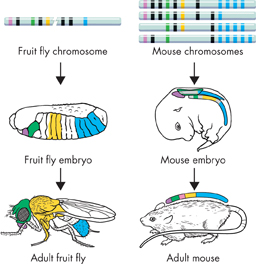Homeotic Genes The American biologist Edward B. Lewis was the first to show that a specific group of genes controls the identities of body parts in the embryo of the common fruit fly. Lewis found that a mutation in one of these genes actually resulted in a fly with a leg growing out of its head in place of an antenna! From Lewis's work it became clear that a set of master control genes, known as homeotic genes, regulates organs that develop in specific parts of the body.

FIGURE 13–20 Hox Genes and Body Development In fruit flies, a series of Hox genes along a chromosome determines the basic body structure. Mice have similar genes on four different chromosomes. The colored areas on the fly and mouse show the approximate body areas affected by genes of the corresponding colors. Interpret Visuals What section of the bodies of flies and mice is coded by the genes shown in blue?
dHomeobox and Hox Genes Molecular studies of homeotic genes show that they share a very similar 180-base DNA sequence, which was given the name homeobox. Homeobox genes code for transcription factors that activate other genes that are important in cell development and differentiation. Homeobox genes are expressed in certain regions of the body, and they determine factors like the presence of wings or legs.
In flies, a group of homeobox genes known as Hox genes are located side by side in a single cluster, as shown in Figure 13–20. Hox genes determine the identities of each segment of a fly's body. They are arranged in the exact order in which they are expressed, from anterior to posterior. A mutation in one of these genes can completely change the organs that develop in specific parts of the body.
Remarkably, clusters of Hox genes exist in the DNA of other animals, including humans. These genes are arranged in the same way—from head to tail. The function of Hox genes in humans seems to be almost the same as it is in fruit flies: They tell the cells of the body how to differentiate as the body grows. What this means, of course, is that nearly all animals, from flies to mammals, share the same basic tools for building the different parts of the body.
The striking similarity of master control genes—genes that control development—has a simple scientific explanation. Common patterns of genetic control exist because all these genes have descended from the genes of common ancestors.  Master control genes are like switches that trigger particular patterns of development and differentiation in cells and tissues. The details can vary from one organism to another, but the switches are nearly identical. Recent studies have shown that the very same Hox gene that triggers the development of hands and feet is also active in the fins of certain fish.
Master control genes are like switches that trigger particular patterns of development and differentiation in cells and tissues. The details can vary from one organism to another, but the switches are nearly identical. Recent studies have shown that the very same Hox gene that triggers the development of hands and feet is also active in the fins of certain fish.
MYSTERY CLUE

What do you think controls the growth and development of eyes in flies and mice?
Table of Contents
- Formulas and Equations
- Applying Formulas and Equations
- Mean, Median, and Mode
- Estimation
- Using Measurements in Calculations
- Effects of Measurement Errors
- Accuracy
- Precision
- Comparing Accuracy and Precision
- Significant Figures
- Calculating With Significant Figures
- Scientific Notation
- Calculating With Scientific Notation
- Dimensional Analysis
- Applying Dimensional Analysis




